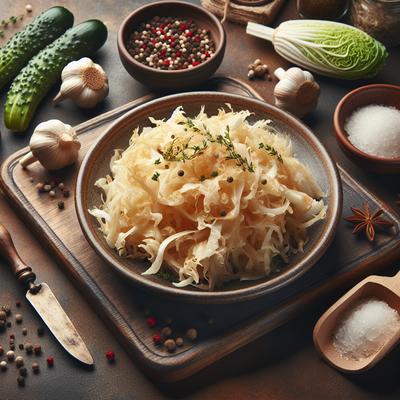Chris Sauerkraut

Discover the art of homemade fermentation with this easy "Chris Sauerkraut" recipe, a flavorful and nutritious way to elevate your meals. Made with just four simple ingredients—crisp green cabbage, kosher salt, optional caraway seeds, and filtered water—this step-by-step guide teaches you how to create tangy, probiotic-rich sauerkraut in your own kitchen. The hands-on process of shredding, salting, and massaging the cabbage releases its natural brine, while a few weeks of fermentation unlocks its signature tangy depth. Perfect as a crunchy side dish, sandwich topping, or ingredient in your favorite recipes, this DIY sauerkraut is the ultimate way to add a healthy dose of flavor and gut-boosting benefits to any meal. Learn how to ferment like a pro and keep your sauerkraut fresh for months with this easy-to-follow, beginner-friendly recipe!

Log this recipe in SnapCalorie

Recipe Information
Ingredients
- 2 heads Green cabbage
- 3 tablespoons Kosher salt
- 1 tablespoon Caraway seeds (optional)
- 2 cups Filtered water (if needed)
Instructions
Remove any damaged outer leaves from the cabbage. Cut the cabbage into quarters and remove the core. Slice the cabbage into thin shreds using a sharp knife, mandoline, or food processor.
Place the shredded cabbage in a large mixing bowl and sprinkle with the kosher salt. Let it sit for 10 minutes to begin to release moisture.
Using clean hands, massage the cabbage vigorously for 5-10 minutes until it becomes soft and releases more liquid. This liquid will become the brine for the sauerkraut.
If using, mix in the caraway seeds for added flavor.
Transfer the cabbage and its liquid to a clean, sterilized wide-mouth glass jar or fermentation crock. Pack it down firmly with a spoon or tamper to remove air pockets and ensure the liquid covers the cabbage completely.
If the natural brine doesn’t completely submerge the cabbage, add a small amount of filtered water to ensure all cabbage is covered by liquid.
Place a weight (a clean glass fermentation weight or smaller jar filled with water) on top of the cabbage to keep it submerged under the brine. Cover the jar or crock with a clean cloth or loosely fitted lid to allow gases to escape while keeping dust and pests out.
Store the jar in a cool, dark place (ideally between 65-72°F or 18-22°C). Allow it to ferment for at least 5-7 days, but up to 2-4 weeks for a stronger flavor. Check daily to ensure the cabbage remains submerged and skim off any scum that may form on the surface of the liquid.
Taste the sauerkraut after 5 days to determine if it's reached your preferred level of tanginess. When it’s ready, transfer it to the refrigerator to slow the fermentation process.
Serve as a side dish, sandwich topping, or ingredient in other recipes. Homemade sauerkraut will keep in the refrigerator for several months if stored in an airtight container.
Nutrition Facts
Calories |
191 | ||
|---|---|---|---|
% Daily Value* |
|||
| Total Fat | 1.6 g | 2% | |
| Saturated Fat | 0.2 g | 1% | |
| Polyunsaturated Fat | 0.0 g | ||
| Cholesterol | 0 mg | 0% | |
| Sodium | 5434 mg | 236% | |
| Total Carbohydrate | 42.7 g | 16% | |
| Dietary Fiber | 19.4 g | 69% | |
| Total Sugars | 21.9 g | ||
| Protein | 10.1 g | 20% | |
| Vitamin D | 0.0 mcg | 0% | |
| Calcium | 315 mg | 24% | |
| Iron | 4.2 mg | 23% | |
| Potassium | 1244 mg | 26% | |
*The % Daily Value tells you how much a nutrient in a serving of food contributes to a daily diet. 2,000 calories a day is used for general nutrition advice.



